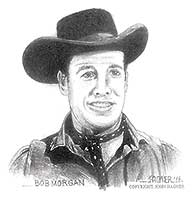

They want you.” Morgan’s intimidating stature and his ability to take a beating meant that he didn’t have to pretend to be a badass he was a badass. “The best acting advice I ever got was from a gentleman in Hollywood,” says Morgan. (For instance, he played Mercenary One in the Oscar-nominated Western Heaven’s Gate.) However, even in his acting roles, he did little acting, instead playing to his strengths as a stuntman. When he wasn’t being a double for the villain, Morgan was usually playing an onscreen role as a mobster or outlaw. He looked the part of a rough-and-tumble character and he embraced it. He had a large build, was fit, and had a busted up nose from his pre-stunting days as a boxer. Besides, Morgan’s physically intimidating presence was better suited for villainous roles. Since the villain would take a beating and appear in the script until the end, it meant there was a lot of stunt work for his double. While the other stuntmen were competing for the part of the hero’s double (typically to impress the ladies), Morgan would vie for the less glitzy role as the lead villain’s double. Morgan learned quickly in Hollywood that the glamorous roles were not the well-paying roles.
#Stuntman bob full#
“Especially a full head burn – that was worth $10,000.” “The great thing about being set on fire was that it paid well,” says Bruce Morgan. Though his parts were often relatively minor, Morgan’s stunt performances enhanced the illusion of reality in every film and television show he appeared in, whether he was taking punches, falling off a horse, or being set on fire. He broke ribs, toes, teeth, and an arm, literally pouring blood and sweat into his roles. You’re not going to make money playing cowboys and Indians.’ So I went to Hollywood and proved him wrong.”įor over fifteen years, Bruce Morgan put himself in physical danger for the sake of good cinema. Also note how Ross Martin knew his limitations and never took the chances.“When I was a kid, my dad would say, ‘Tie that horse up and do your homework. Their style of fighting is very consistent, in order to survive all that action within the episodes. Mannix (Mike Connors) does the same thing. Watch West closely in fist fights, his center of gravity is very low, and he puts all his energy into "throwing" the punch, but the camera angle means he doesn't touch is opponent. So they had a couple of identicals in reserve so that a costuming mishap would NOT hold up production! Even Costuming said they had a tough time regarding his clothes, because he was always ripping them. I believe (but welcome correction) is that RC was also a boxing enthusiast. Even falling from a horse, the horse is trained for it, and falls on cue. RC said he learned much from his mentors to augment his instinct for action and acting. If stunt people aren't continually successful and reliable, they don't get the next job, so they have more to loose. And, as all Fans know, it's about how and where actors fall (for example).

That means, in response to any scene, the action is first choregraphed properly. They were made up to look differently for the episodes, but they all worked together routinely. There are other articles, where he said, they did all the action with about 5 regular stunt people. They had an agreement to fill with the Network which gave them the go-ahead for so many episodes per season. Not just about compensation but reputation and reliability.

No one (meaning anyone) would be more impacted by a shut down or delay than those immediately involved. Not at all, and not to be disagreeable, just extending the conversation 😉 "I can't afford fist fights either, because the legal fees are astronomical." With that said, there were other benefits to having all of the fights, falls and bruises take place infront of a camera and not in the streets. So, according to Conrad, he may not have looked for trouble, but he didn't shy away from it either. In fact, I do everything I can to avoid confrontation, but if someone really gets on my case, I cool him fast. Though he had altercations before, he never wanted a fight. With this mindset, Conrad "performed more than 500 stunts in and never used a double," according to the article.įrom his time as detective Tom Lopaka on Hawaiian Eye to his Jim West character, that tough guy persona followed him whether he wanted it or not. "Why pay a double $1,300 for a $150 stunt that I knew I could do better?" he said. Conrad felt he did them better than any stuntman would, and it'd be cheaper. Doing his own stunts throughout his career went beyond trading a bruise for a buck. While that notion was true for the Northwestern University drama department graduate, it wasn't the whole story. Did you know? Robert Conrad couldn't escape his tough guy image - but he could dodge police!


 0 kommentar(er)
0 kommentar(er)
